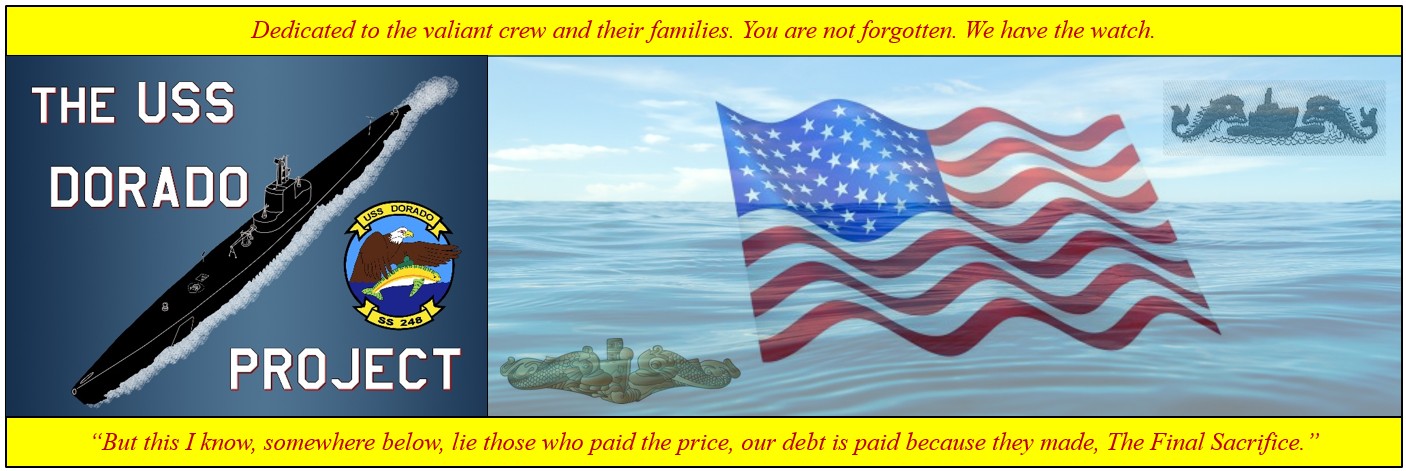Dorado Loss Scenario: Difference between revisions
Pbcjohnston (talk | contribs) mNo edit summary |
Pbcjohnston (talk | contribs) Adding text and pics to The Loss Scenario |
||
| Line 13: | Line 13: | ||
__TOC__</center> | __TOC__</center> | ||
<div style="text-align: justify;"><span style="color:#000000"> | |||
==The Departure== | |||
[[File:Flasher Mod 3 photo 1.jpg|left|thumb|400px|<small>USS Flasher (SS-249), Dorado's sister boat, on sea trials in 1943. Dorado would have been configured very close to this when she left for war. NARA photo #80-G-450241 via Navsource.net.</small>]] | |||
<div style="text-align: justify;"><span style="color:#00008B">On the morning of October 6, 1943, Dorado backed smartly out of her slip at Submarine Base New London, Groton, CT., put on some left rudder, and swung her stern to the north and up river. Expertly timing the swing, LCDR Schneider, present on the bridge with several other crewmen, ordered zero rudder and all stop. He then ordered "all ahead two thirds" and Dorado began her trip down the Thames River, headed to Long Island Sound and eventually the Atlantic Ocean. | |||
She passed under the U.S. Route 1 bridge, with the venerable structure lifted open to allow the boat to pass underneath. She passed the main Electric Boat facility on her port beam, and a little further downstream she passed the Victory Yard where she was built. Men and women toiling in the cool October air on Dorado's sister subs paused for a moment, proudly acknowledging their handiwork as the submarine passed. They wished her luck as she headed off to war. | |||
Fishing vessels hailed her as she passed the mouth of the Thames and Schneider rang up an ahead standard bell with turns for 14 knots. The bridge watch team kept a wary eye on the Fisher's Island and Montauk ferries as they passed, with a little maneuvering left and right intended to keep the ferries at a safe distance. Clearing Fisher's Island she made a slight turn to the southeast, putting her on course to pass down the middle between Montauk Point on her starboard side and Block Island on her port. Down below in the control room the Quartermasters and the Navigator were busy piloting the submarine, shooting bearings with the periscope to land-based navigation aids, using those bearings to triangulate their position on the chart. With Montauk Point on their starboard quarter, they took their "point of departure", i.e. the last confirmed land-based navigational fix, and headed out into the blue Atlantic. | |||
<center>[[File:RWB Starbar ver 3.jpg|300px]]</center> | |||
<div style="text-align: justify;"><span style="color:#000000"> | <div style="text-align: justify;"><span style="color:#000000"> | ||
==The Voyage== | |||
[[File:Dorado route 6 to 14 Oct 43.jpg|left|thumb|400px|<small>Graphic ©Thaddeus Weaver, 2025</small>]] | |||
<div style="text-align: justify;"><span style="color:#00008B">Dorado's orders for the first leg of her voyage is called a Movement Order, or MOVORD. Dorado's MOVORD contained seven waypoints, Able to George. They would route her out into the Atlantic and south towards the Caribbean. Her destination was Submarine Base Coco Solo, on the Atlantic side of the Panama Canal near the city of Colon. | |||
<center>[[File:Subs bottom line 2.jpg]] | <center>[[File:Subs bottom line 2.jpg]] | ||
Revision as of 16:31, 27 June 2025

| Main Page | Latest News & Updates | The Submarine | The Crew | Photographs | The Loss Scenario | The Aircraft | Case for the Purple Heart | The Myths | Research Documents |
The Departure

She passed under the U.S. Route 1 bridge, with the venerable structure lifted open to allow the boat to pass underneath. She passed the main Electric Boat facility on her port beam, and a little further downstream she passed the Victory Yard where she was built. Men and women toiling in the cool October air on Dorado's sister subs paused for a moment, proudly acknowledging their handiwork as the submarine passed. They wished her luck as she headed off to war.
Fishing vessels hailed her as she passed the mouth of the Thames and Schneider rang up an ahead standard bell with turns for 14 knots. The bridge watch team kept a wary eye on the Fisher's Island and Montauk ferries as they passed, with a little maneuvering left and right intended to keep the ferries at a safe distance. Clearing Fisher's Island she made a slight turn to the southeast, putting her on course to pass down the middle between Montauk Point on her starboard side and Block Island on her port. Down below in the control room the Quartermasters and the Navigator were busy piloting the submarine, shooting bearings with the periscope to land-based navigation aids, using those bearings to triangulate their position on the chart. With Montauk Point on their starboard quarter, they took their "point of departure", i.e. the last confirmed land-based navigational fix, and headed out into the blue Atlantic.
The Voyage

Page created by:
Thaddeus Weaver & David Johnston
©2025 - Thaddeus Weaver & PigBoats.COM
West Warwick, RI, Norfolk, VA
ussdoradoproject@gmail.com